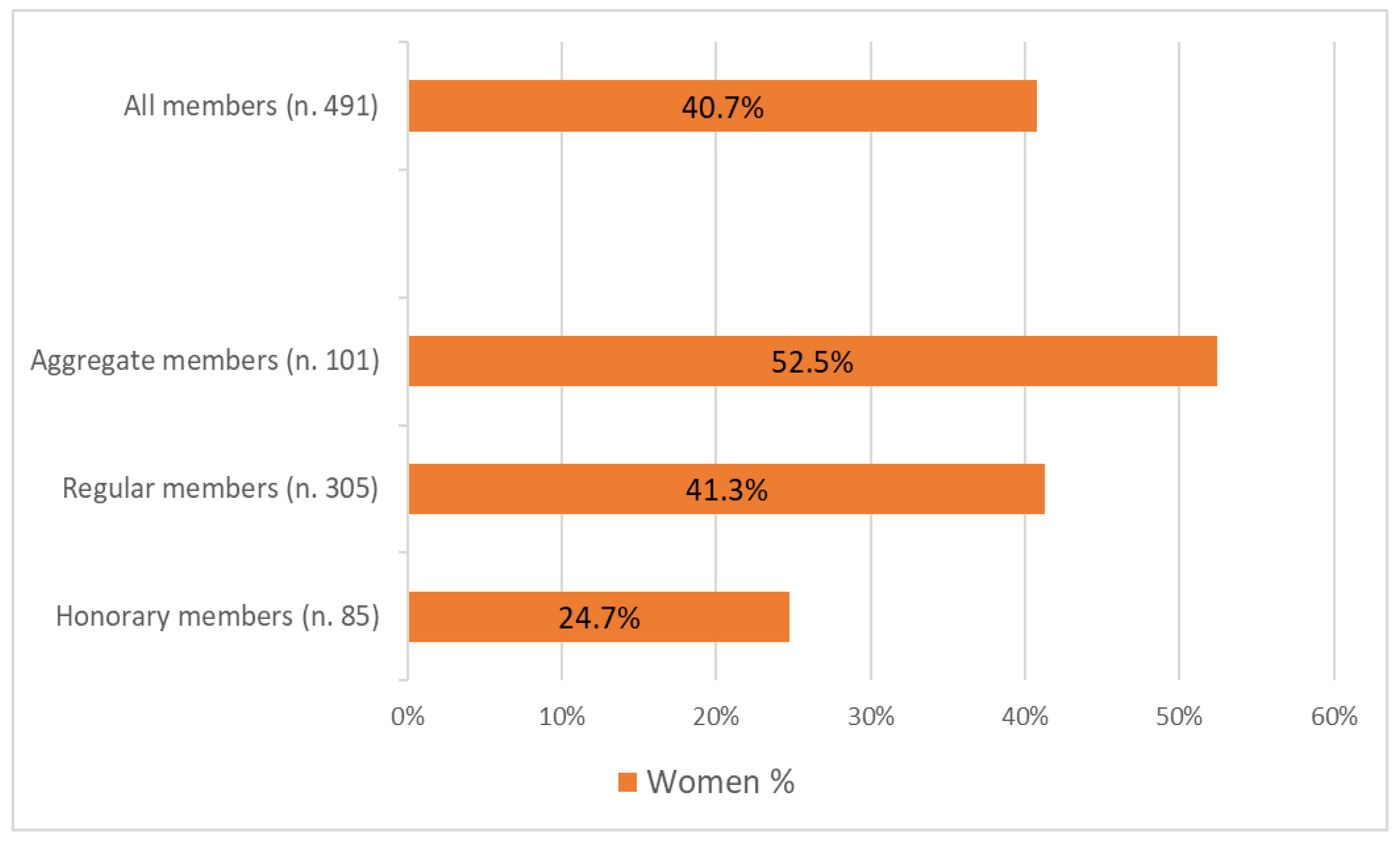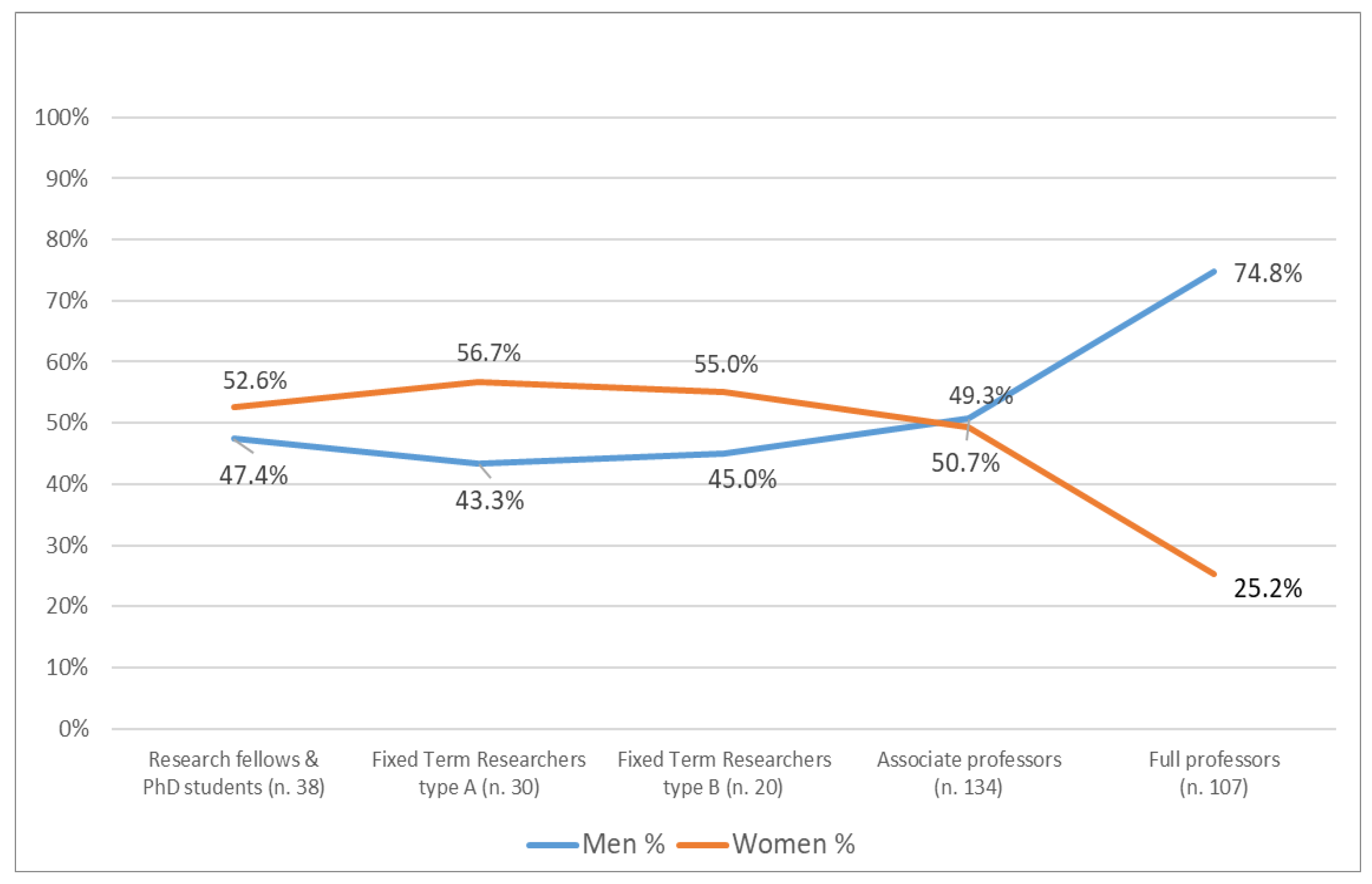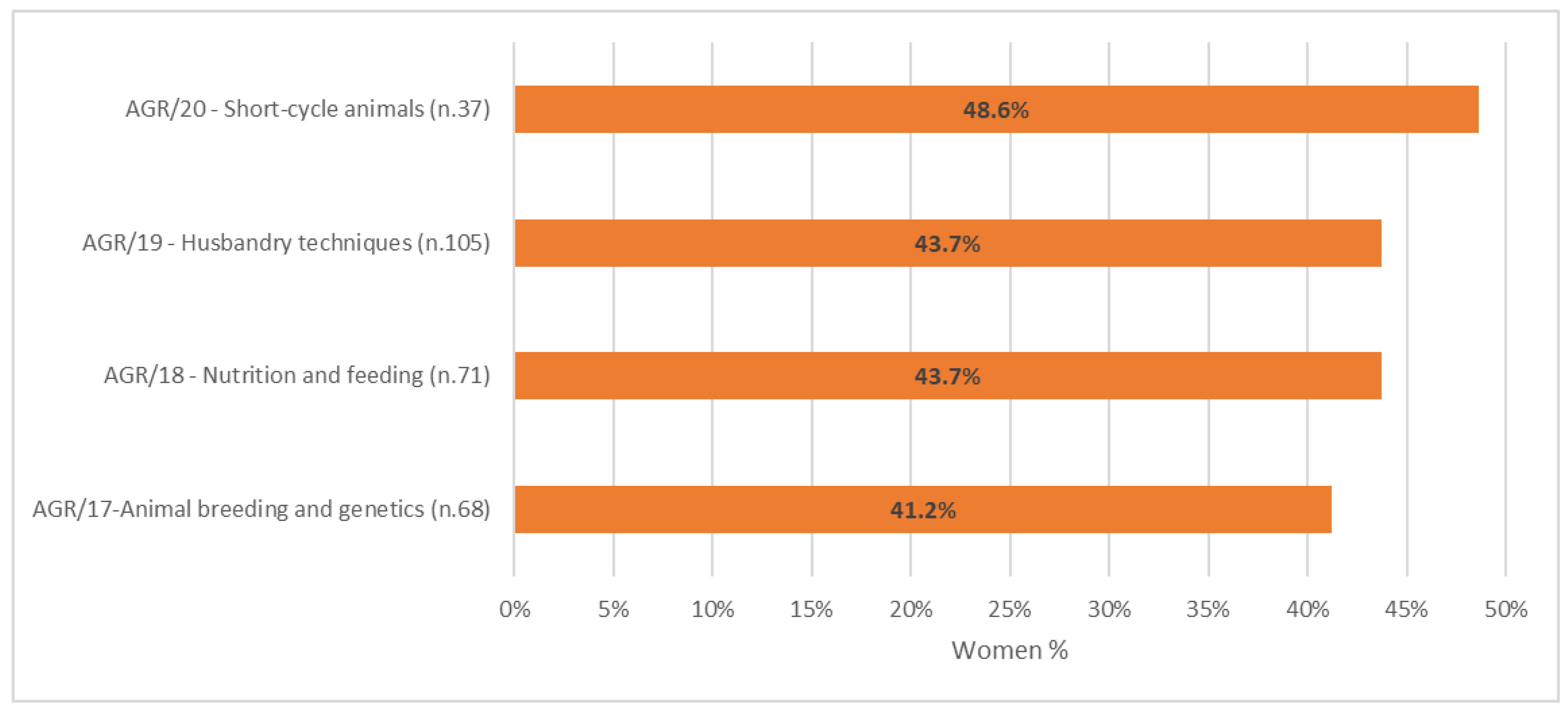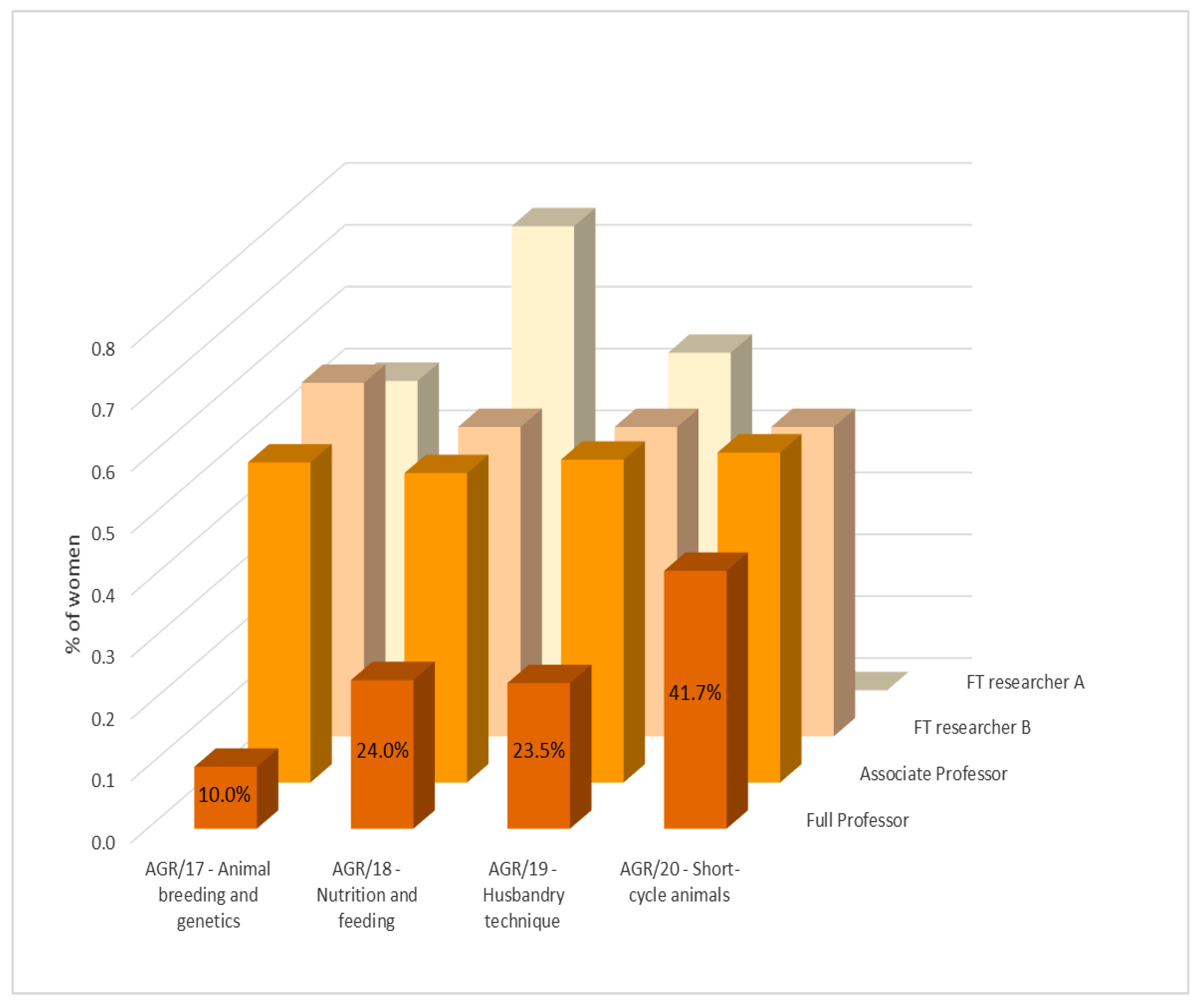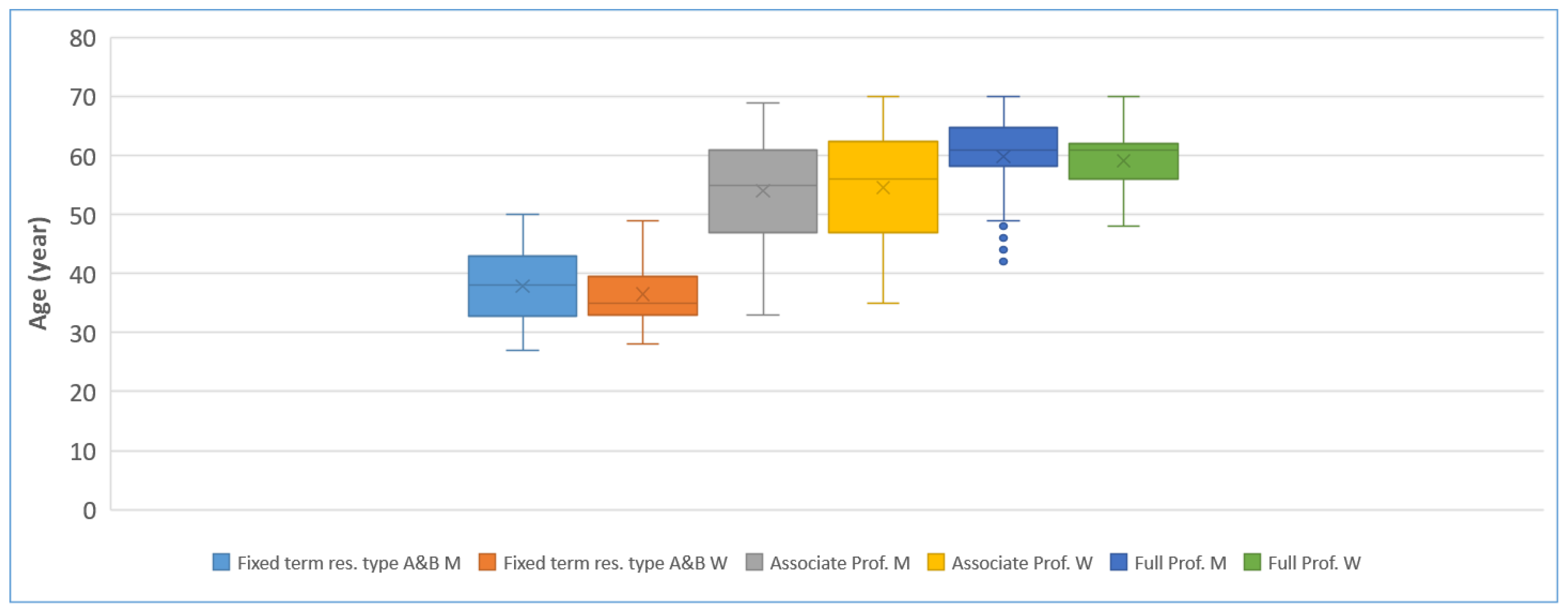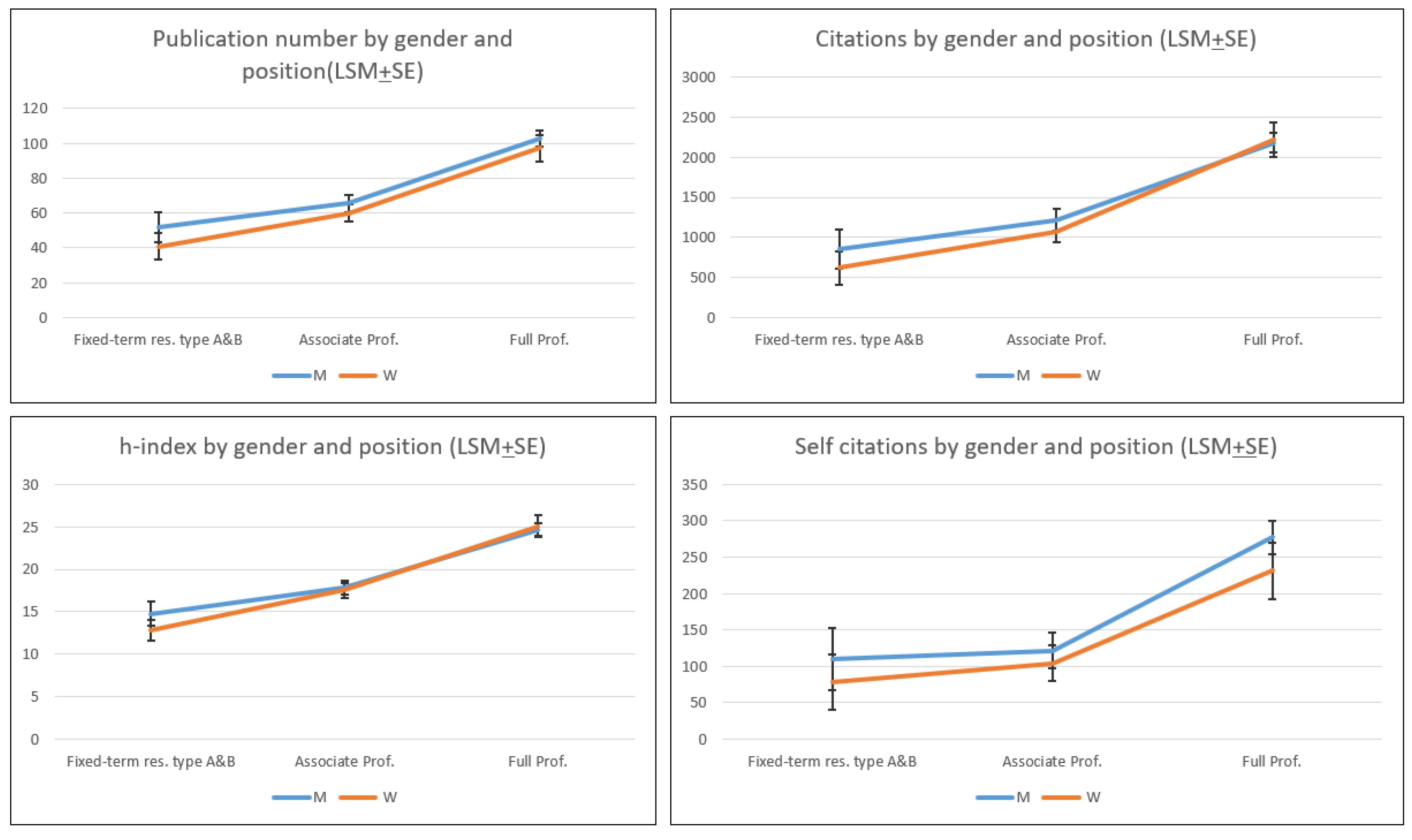4.1. Gender Distribution of Members in the ASPA
In 2023, the Association for Science and Animal Production counted a total of 491 members, considering only individuals and excluding organizations. Members were classified into three categories: honorary members (retired members), regular members, and aggregate members. According to ASPA’s statute, aggregate members are young individuals undergoing training in animal science research, including doctoral students, research fellows, and grant holders. Upon completing their training and transitioning to stable positions as researchers, they become regular members.
Figure 1 illustrates the percentage of women within the entire association and across the three membership groups. When considering only aggregate and regular members (excluding honorary members), women account for 46.5%. Among aggregate members, the proportion of women is 52.5%, markedly exceeding the overall average.
According to statistics from the European Union (EU), the proportion of women among doctoral graduates has shown a slight increase in the last decade, reaching 48.1% in 2018 (EU-27) [
11]. This outcome suggests that, without differentiation by the field of study, gender parity between female and male doctoral graduates has almost been achieved at the European level, indicating gradual progress towards gender equality over time. At the Italian level, the proportion of female doctoral graduates is slightly higher than at the European level, although the evolution between 2010 and 2018 recorded a slight reduction in the percentage of young women obtaining a doctoral degree, from 53.2% to 50.5% [
11]. In particular, when examining the specific fields of “Agriculture, forestry, fisheries and veterinary”, which are closely related to but not completely overlapping the field of animal sciences, the percentage of women gaining a doctorate in 2018 was 56.8% at the European level (EU-27) and 56.3% at the Italian level. These figures are slightly higher than the 52.5% percentage of aggregate members of the ASPA, which also includes research fellows.
The ASPA was established just over 50 years ago (1973), with only 3 out of its 28 founding members (10.7%) being women. Over time, the percentage of women in the association has steadily increased, rising from 20.6% in 1994 to 40.9% in 2023, reflecting a nearly threefold growth over 30 years.
The association primarily includes scientists from all Italian universities and other research organizations, along with a small number of technicians and professionals. Its members are distributed across eighteen regions in Italy. Membership is exclusively male in two regions, while thirteen regions exhibit a male majority, one achieves gender parity, and two have a female majority.
Academic members constitute the vast majority, representing 88.2% of the association when excluding honorary members. In contrast, among non-academic, non-honorary members, gender parity (50:50) is observed, demonstrating a more balanced distribution compared to their academic counterparts.
The academic members of the association represent almost the entire cohort of Italian academics within the field of animal sciences and technologies, which totals 409 scientists, 46.7% of whom are women.
When classifying academic members (aggregate and regular members) by position and gender, a notable gender disparity emerges in the full professor position (
Figure 2). The figure does not include the category of tenured university researchers as this category is being phased out and is no longer renewed. Notably, women represent 57% of the tenured researcher category.
The diagram highlights the typical “scissor-like” trend that characterizes the male-to-female ratio at different career levels: the female component consistently dominates in lower-level positions but becomes a minority in higher-level positions, as confirmed also by the glass ceiling index, which is equal to 1.7. The balance point corresponds to the position of associate professor. This trend, with some differences, is also confirmed at the national level concerning academic staff in 2020 [
13]. A similar trend among academic staff is also reported at the European level [
14]. According to this report, while the overall percentage of women in academic roles is generally close to parity, the representation of women significantly decreases in higher positions. In 2018 (EU-27), the proportion of women declined from nearly half (46.6%) in grade C positions (PhD holders) to 40.3% in grade B (more senior) positions. There was a further decline to approximately one-quarter of women (26.2%) in the grade A positions, which represents the highest grade at which research is typically conducted within the institutional or corporate system. Moreover, it should be emphasized that from 2015 to 2018, the improvement at the European level appears minimal, indicating a prolonged path toward gender parity. In Italy in 2018, only 23.7% of grade A positions in academic environments were held by women.
The gap is particularly noticeable in Scientific Disciplinary Sectors compared to social and humanities disciplines: the proportion of women in category A was 17.9% and 28.5% in Engineering and Technology and Agricultural Sciences, respectively, while, in social and humanities sciences, it exceeded 30% in 2018. In Italy, the situation appears even more imbalanced, with only 13.8% and 19.5% of grade A positions being held by women in the fields of Engineering and Technology and Agricultural Sciences, respectively [
11].
The “scissor effect” refers to a prevalent trend of vertical segregation observed across various work domains. However, as highlighted by Farina et al. (2023) and other authors, gender disparities are particularly pronounced in the academic and research spheres, with progress toward overcoming these inequalities advancing at an exceptionally slow pace [
14]. The representation of women declines as if there were a “leaky pipeline” during advancement from junior to senior academic positions, with high attrition rates observed [
15]. The under-representation of women in higher career positions can be attributed to both the “leaky pipeline” and “glass ceiling” phenomena. The former refers to the effect of women leaving the career pipeline at various stages while the latter pertains to structural barriers such as discrimination and gender bias that hinder women’s access to top decision-making and managerial roles [
11].
The causes of vertical segregation in academic careers are multifaceted, complex, and interconnected. On one hand, there is a well-documented, lower scientific productivity among women compared to men based on commonly used indicators for assessing scientific output: the number of publications, citations, and citation indexes [
16]. The lower scientific productivity of women could be partially attributed to the greater family responsibilities of women, not only childcare but also caring for elderly and disabled family members. These family commitments compete with research activities but also limit opportunities for travelling and the establishment of national and international networks, both crucial factors for accessing funding and publishing scientific work. It is not coincidental that the international mobility of European female doctoral candidates is higher than that of their male counterparts, while among senior researchers, the ratio is reversed, with men exhibiting greater international mobility [
11]. The lower mobility of female senior researchers translates into fewer international contacts and opportunities to secure international grants with international teams, leading to diminished chances of publishing and lower visibility in the academic world.
Moreover, within the academic context, women tend to exhibit a stronger inclination than men towards educational activities (teaching and mentoring) and administrative tasks, thus diverting time away from research [
17,
18]. In addition, several authors have highlighted that female researchers may be more hesitant to participate in competitions due to a lack of self-confidence [
19].
According to Filandri and Pasqua (2021), who analyzed career advancement using data from the entire population of researchers and professors in the Italian university system, a significant gender gap in career progression emerges [
18]. The analysis revealed that, in this case, the gap cannot be attributed to lower scientific productivity or women’s reluctance to seek promotions. Instead, it exposed structural gender biases. These biases, partly conscious and partly unconscious, are likely to contribute to undervaluing the performances and scientific competencies of women. For instance, the study by Jappelli et al. (2017) suggests that research papers authored by women receive less favourable evaluations [
16]. Bendels et al. (2018), analyzing 295,557 research articles from 54 journals listed in the Nature index, highlighted that women are authors of fewer articles than men (two articles fewer per year), and articles with female key authors are cited less frequently [
20]. The gender difference in citation rates increases as the number of authors contributing to an article increases. The authors concluded that the prognosis for the coming decades predicts a really poor harmonization of disparity between the two genders. Furthermore, additional barriers to career progression include working cultures that lack gender sensitivity and fail to accommodate family commitments, incidents of sexual harassment, bullying, gender-based violence, and differences in individual choices and behaviour based on gender [
13].
As a result, lower proportions of women, relative to men, attain full professorship positions, which are considered as a pre-requisite for top-level decision-making roles such as faculty heads or university rectors. These positions are generally associated with “desirable” attributes, including higher salaries, prestige, social security, and adequate pension benefits. In the academic context, the over-representation of men among heads of universities is an example of such vertical segregation. A South Korean study found that gender quotas improved female faculty representation at all tenure levels but not in senior leadership roles like the dean or president. This suggests that entry-level quotas may not suffice to address gender inequality at higher academic levels. Evidence of their effectiveness across disciplines indicates limited and slow progress in fields where women are severely under-represented [
21].
In addition to vertical segregation, horizontal segregation was investigated by examining the gender distribution across Scientific Disciplinary Sectors among the association’s members. The analysis revealed a clear predominance of men in disciplines related to Animal breeding and genetics (AGR/17; see
Figure 3), which are more closely associated with STEM fields. Values indicating closer gender balance were observed in disciplines related to Short-cycle animals, such as fish, poultry, laboratory and fur animals, birds, and rabbits (AGR/20).
Horizontal segregation refers to the concentration of women and men in different sectors (sectoral segregation) and occupations (occupational segregation) [
22]. It can occur within education with over- or under-representation of one gender in specific subjects and employment with over- or under-representation of one gender in specific professions, industries, etc. The issue of horizontal segregation may in turn lead to increased vertical segregation. For instance, undervaluing competencies associated with “women’s work” may limit women’s prospects for career advancement [
11].
Out of the 281 academic regular members, 44% are women. Within the SDSs, women represent 41.2% in Animal breeding and genetics and 48.6% in Short-cycle animals.
Although in the field of Animal breeding and genetics (AGR 17) a smaller percentage of women is observed, this value is not significantly different from the overall average of 44% of women across all SDSs. However, it can be noticed that in three out of the four SDSs considered (AGR17, AGR18, AGR19), there is a strong vertical segregation, with the number of female full professors significantly lower compared to men. Only in the AGR20 sector, gender differences across academic positions are minimal and not statistically significant. In the field of Animal breeding and genetics (AGR/17), the strongest vertical segregation is observed, with a very low percentage of women in full professor positions (10%) compared to other SDSs (
Figure 4), probably linked to a stronger gender prejudice that considers statistics and calculation as a prerogative of men, as in other STEM disciplines. This is particularly concerning given the growing reliance of animal science and the wider agricultural sector on precision livestock farming and artificial intelligence tools, making these fields increasingly interconnected with STEM disciplines. A lack of female representation may limit diverse perspectives in a sector that is advancing rapidly through technological and scientific innovations. This perspective is invaluable as we aim to develop innovative solutions that not only increase productivity but also support broader goals of ecological and social sustainability [
23]. In-depth analyses of the role of women in promoting environmental and social sustainability have been published recently in various fields [
24,
25].
The percentages of women reported in
Figure 4 reflect the proportion of women present in the four SDSs at the national level in the Italian university system. Overall, women constitute 45.9% of the total, and the percentage of women among full professors is 12.5% in AGR/17, 30.8% in AGR/18, 26.3% in AGR/19, and 58.3% in AGR/20, based on data from the official website of the Italian university system [
26,
27]. It is worth noting that the EU defines gender parity as a 50:50 ratio and gender equality as a proportion between 40 and 60%. In the case of full professors, there is an evident inequality as confirmed by the glass ceiling index which exceeds 1 in three out of the four SDSs.
Vertical segregation in the SDSs of animal science in Italy could be calculated as the proportion of women and men who are full professors over the total number of women and men in academic environments (from full professors to tenure track researchers and fixed-term type B and A researchers). This results in a significant difference (p-value = 0.0014) with percentages of 15.7% and 34.3% for women and men, respectively. The opportunity for women to become full professors, calculated as relative risk, was 0.44 in 2023, whereas, in 2013, it was 0.27 (when the percentages of women and men full professors were 9.6% and 35.2%).
Vertical segregation could also be seen from the glass ceiling indexes, equal to 2.2 for AGR/17, 1.8 for AGR/18, 1.6 for AGR/19, and 0.9 for AGR/20. These indexes show that in three out of the four SDSs with a value higher than 1, a strong vertical segregation is currently present. The GCIs for the above sectors in 2013 were 1.7, 2.2, 5.3, and 1, respectively. Although in some SDSs, the GCI has improved over the last 10 years; by calculating the GCI for the four SSDs together in the same 10 years, it moves from 1.7 to 1.6.
When comparing the values of 2023 with those of 2013, there has been an increment of approximately 0.6% per year in the number of women full professors and a decrease of 0.1 in the GCI. It can be estimated that it will take approximately 60 years, given the same trends, to have equal opportunities for women and men to access top positions in the four SDSs in animal science.
The probability for a woman to become a full professor is significantly lower (p-value < 0.05) in three out of the four SDSs evaluated. Women (and men) in AGR17, 18, and 19 show values of 7.7% (40.4%), 17.4% (38.3%), and 15.9% (34.1%), respectively. Only in the AGR/20 sector is there a higher but not statistically different value for women (vs. men), equal to 23.3% (17.2%). Overall, women have a probability of becoming full professors equal to 0.44 while men have 2.3 times that probability. These values underline a persistent inequality of opportunity for women to reach the position of full professor, contributing to a gender gap in salaries and retirement pensions that accumulate disadvantages throughout the entire career of a woman scientist. It would also be interesting to evaluate these data with respect to academic age, defined as the age at which individuals achieve different career milestones; however, the necessary data are not available.
While animal sciences, as a whole, may not fall entirely within the STEM category (Science, Technology, Engineering, and Mathematics), certain disciplinary areas within it encompass STEM skills. Research in the field of Animal breeding and genetics now demands proficiency in mathematics, statistics, and computer science. Despite improvements in recent years, women working in STEM fields are still in the minority. According to the 2023 report on gender equality in the EU [
26], the proportion of women graduating in STEM disciplines is persistently lower than that of men and is relatively stable: there are two men graduating in tertiary education in STEM disciplines for every woman. The ratio is slightly better at the master’s or equivalent level and at the doctoral level (respectively, 1.5 and 1.8 men for every woman in 2020) [
27].
As previously highlighted, when discussing doctoral graduates, at both European and Italian levels, women graduates were over-represented in the field of Education and under-represented in the broad fields of ICT and Engineering, Manufacturing, and Construction [
11]. For instance, in Italy, out of 100 female students who enrol in university, only 21 choose STEM degree courses. Moreover, among all those enrolled in STEM faculties, female students represented only 37% [
28]. This gender gap is present not only in Italy but also in Europe and around the world. As teaching and learning cultures can be influenced by gender stereotypes and unconscious biases, this may constitute a barrier to women’s progression in STEM fields [
29]. Some of the contributing factors to this situation include gender stereotypes, lack of female role models in STEM disciplines, and differences in education and perception of these disciplines [
30].
In the EU, men dominate 85% of all top-level positions in STEM fields [
28]. These data suggest that the extent of vertical segregation in career paths for women in academic environments is more pronounced in the field of STEM. Particularly in STEM, women face barriers including biases from hiring committees, lack of mentoring, social marginalization, inhospitable group cultures, lower salaries, fewer resources, less respect, lower likelihood of promotion, and even overt opposition to hiring female faculty members [
31].
4.3. Bibliometrics of the ASPA Members
The scientific performances of the ASPA academic members belonging to the three main categories (fixed-term researchers type A and B, associate professor, and full professor) were analyzed by examining key bibliometric parameters (no. of publications, h-index, no. of citations, and no. of self-citations). These data were collected by Scopus in March 2023.
When considering only gender as a source of variation, statistically significant differences between women and men are observed for the four variables considered and age (
Table 1). Men outperform women in all the variables considered, with a statistically significant average (and median) difference in favour of men equal to 17.3 (9.5) documents, 2.5 (2.0) points of h-index, 391.5 (189.5) citations, and 66.3 (13) self-citations. Moreover, the average age of male authors is 3.5 years higher than that of females. This model explains only 2.3 to 3.3 percent of the observed variability. The differences remain significant even when using Welch’s test for the variables that show unequal variances (publication numbers, citations, and self-citations).
This effect is clearly shown in
Figure 5, where a higher number of male outliers in terms of the number of documents can be observed. For this metric, out of the 24 top researchers in the first 10% of the distribution, 33% are women. All of the top male researchers hold full professor positions, whereas among women, only 75% are full professors. This observation aligns with findings from previous studies [
32], indicating that gender disparities in academic environments can largely be attributed to the extremes of the distribution, notably the disproportionate representation of men among the highest-achieving scientists.
Owing to the low variability explained by the previous model, which considers gender as the sole source of variation, a three-way ANCOVA model was applied, including gender, academic position, and scientific sector as fixed factors with age as a covariate.
It is worth noting that a logarithmic transformation for the variables citations and self-citations was also explored to address the funnel pattern observed in the residuals. However, this transformation did not alter the significance of the factors. Firstly, a saturated model incorporating two- and three-way interactions was applied, but none of these interactions proved statistically significant and were thus removed from the model.
With this model, gender consistently showed no significance for the four bibliometric variables considered (
Table 2). On the contrary, academic positions, including fixed-term researchers type A and B, associate and full professors, consistently yielded high significance, emerging as the most important source of variation, as demonstrated by the highest Logworth value. In addition, the SDSs were significant, although the Logworth was lower, except for the h-index. The covariate age also proved significant for all the metrics considered, with Logworths lower than those for the SDSs. The r2 of the model increased for all four variables, with the highest value (0.36) for the h-index and the lowest (0.21) for the self-citations.
The results concerning positions and age align with expectations: as careers progress, the parameters under consideration tend to increase, as illustrated in
Figure 6. Notably, among male full professors, there are more outliers in the younger age bracket, hinting that men often advance more swiftly in their careers and attain higher positions earlier compared to women. Several longitudinal studies have linked the gender gap in bibliometric performance to women’s shorter career durations [
33], a higher representation of women in teaching-intensive and part-time positions [
34], and fewer women in the top positions where both genders achieve the highest performance [
35].
Analyzing a model that incorporates academic age at various career stages by gender would be beneficial, but regrettably, such data are unavailable.
The position emerged as the most crucial factor. Indeed, the exclusion of the full professor category, dominated by older men at 75%, eliminates statistical gender differences. On the other hand, when considering age alone, gender becomes statistically significant, although with a low explained variability when using gender alone in the simplest model.
In
Figure 7, where the Least Square Mean (LSM ± SE) by positions and gender are reported, it is evident that gender is not statistically significant.
Although differences by gender are not statistically significant (
Figure 7), the main descriptive statistics of the distribution by gender and position (
Table 1 and
Supplementary Table S1) show differences starting from early career stages. These disparities persist across the higher positions, although diminished for some metrics. This pattern highlights both the “sticky floor” and “glass ceiling” theories, especially evident in outliers among young male full professors but absent among young female full professors.
To summarize, considering both academic positions and age, statistical parity emerges between men and women in terms of performance. However, academic positions appear as the primary determinant of bibliometric performance. Specifically, the early attainment of full professor positions enhances opportunities for securing research funding, fostering collaborations, and building professional networks.
As Abramo et al. (2021) note, an intriguing question arises: could the employment of bibliometric indicators contribute to a more equitable assessment of female researchers? [
32] Various strategies have been suggested, with the most radical proposal put forward by Abramo et al. (2016) [
35], involving the establishment of performance rankings that differentiate between genders. This proposal stems from the observation, corroborated by our own data, that “when comparing the research performance of individuals within the same gender category, distinct rank positions emerge compared to those rankings that disregard gender distinctions”.
This concept parallels the practice in sports, where gender-specific rankings are common to ensure fair competition and recognition of individual achievements within distinct categories.
4.4. Gender Distribution of Authors on IJAS
The number of papers published on the IJAS by Italian scientists increased over the years (from 27 to 75 papers in the last two decades). In 2002, only 30% of authors were women and the percentage of prestigious positions covered by female scientists was 22%, the lowest value obtained in the four years included in the survey.
The gap between the percentage of female authors and the prestigious positions held by women widened even more in 2008 (−13%) when about one-third of women covered prestigious positions even though the percentage of female authors was nearly 50%. In 2014, the total number of papers published on IJAS increased significantly in comparison to 2008 but the gender distribution remains unchanged. A trend towards achieving a gender balance was observed only in 2021, with a sharp increase in prestigious positions covered by women (41%) despite the lower percentage of female authors (36%) compared to the two previous surveys.
Abramo et al. (2009) studied the research productivity of the Italian academic system between 2001 and 2003 using the Italian Observatory of Public Research (ORP) [
36]. The percentage of Italian female scientists in the disciplinary area of Agriculture and Veterinary Sciences was 27%, and this value is close to the gender distribution of authors in IJAS in 2002 (30%). The authors discovered that in the same period, women were more active (more than one paper per year) than men (52.7% compared to 47.5%). In the report by the European Commission (2018), the women-to-men ratio of authorship in the field of Agricultural Sciences (including animal science) increased from 0.9 to 1.0 in Italy between the five-year periods 2008–2012 and 2013–2017 [
30]. These ratios are similar to the value found in this study in 2008 (0.92) but lower than that of 2014 (0.72), which is closer to the EU-28 ratios (from 0.7 to 0.8 in two periods). According to Ross et al. (2022), women in research teams are significantly less likely than men to be credited with authorship [
37]. An investigation into the gender balance in STEM subject areas in Portugal showed that, among all researchers in any author position, women wrote fewer publications than men and this gap was largest in 2003 or earlier, although it decreased over the years, reaching parity in the five-year period 2014–2018 [
38]. In addition, Bendels et al. (2017), analyzing almost 300.000 articles from 54 journals listed in the Nature index from 2008 to 2016, found that women comprise, on average, 47.6% of all authorship in Italy [
20]. This value is very similar to that obtained in this study considering the two central years (2008 and 2014).
The percentage of female first authors increased sharply from 2002 to 2008 (15 to 41%) and this increase continued linearly in 2014 and 2021 when the 50% threshold was reached. Therefore, the growing role of women in the authorship of scientific articles has been confirmed over the years. Conversely, the percentage of women as last authors remained stable or decreased over time (from 30 to 25%). Typically, the last position is held by the author responsible for acquiring funds and other resources necessary to carry out the experiments. Therefore, these data may reflect some difficulties of women in accessing public and private funding and performing the role of principal investigator.
Johnson et al. (2021) observed that the percentage of reviewed research abstracts with a female last author, during the period 2006–2018 at the Pediatric Orthopedic Society of North America annual meeting, was very low (17.8% of the total) but, in addition, abstracts with women as last authors were significantly less likely to reach publication compared to those with men (59.6 vs. 67.9%;
p < 0.05) [
39]. In the paper by Bendels et al. (2017), women are, on average, 33.1% of the first authors and 18.1% of the last authors at the global level [
20]. The highest average annual growth rate from 2008 to 2016 was found for the last authorship (1.4%) followed by the first authorship (0.7%). This positive trend is confirmed in this study only for the female first authors while, for the female last authors, the percentage is stable (on average 25% in the last three years considered).
Nevertheless, the percentage of women in the role of corresponding author (considered only if this position is different from the first or last author) increased threefold (from 15 to 45%) over the years. This trend is not linked to a corresponding increase over the years in the total number of women involved in the publication of articles (+6%) and could be justified by the fact that women are traditionally believed to have a greater aptitude for managing, rearranging, and proofreading manuscripts, following the stereotype that women are more organized and more persevering than men. This gender stereotype is derived from the unequal distribution of men and women in social roles both in the household and the workplace [
40].
In a recent publication on gender disparities in high-quality research revealed by the Nature index, the writers, who did not have access to the researchers’ academic positions, reported lower productivity for female authors [
20]. In the same publication, the writers also reported that articles with female key authors (first and last) are cited less frequently than articles with male key authors.
This difference in citation rates increases as the number of authors contributing to an article increases, probably due to the strong competition for key positions among female authors. Furthermore, they observed distinct differences at the level of journal, journal category, continent, and country.
